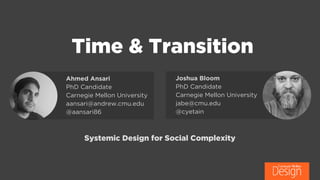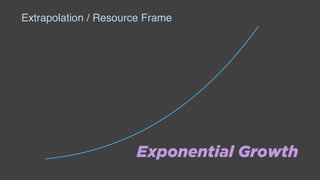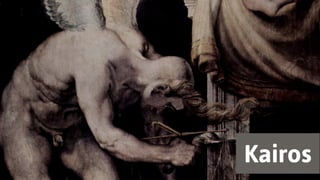Time and Transition : RSD5
- 1. Â Time & Transition Joshua Bloom PhD Candidate Carnegie Mellon University jabe@cmu.edu @cyetain Ahmed Ansari PhD Candidate Carnegie Mellon University aansari@andrew.cmu.edu @aansari86 Systemic Design for Social Complexity
- 2. I am privileged with nearly complete freedom of travel. This privilege allows me to be seen, published and be heard in ways not available to many.
- 3. Design has a key role to play in societal transitions to more sustainable futures Interconnected and interdependent âsystems problemsâ, exist at multiple levels of scale within the social and environmental spheres [Designers need to] understand how to work iteratively, at multiple levels of scale, over long horizons of time COMPLEX TEMPORAL DESIGN TEMPORALLY INFORMED TRANSITION DESIGN TEMPORAL COMPLEXITY
- 6. Present Condition Preferred Condition Idealized Condition Alternate Futures Alternate Futures Alternate Futures Present Mileau Present Mileau Imagined Mileau
- 7. Changing Milieu Present Condition Present Milieu ? ? ? ? ? ? ? ? ? ? ? ? ? ? ? ? ? ? ? ? ? ? ? ? ? ? ? ? ? ? ? ? ? ? ? ?
- 9. Each of us sits in a long dark hall within a circle of light cast by a small lamp. The lamplight penetrates a few feet up and down the hall, then rapidly attenuates, diluted by the vast darkness of future and past that surrounds it. Simon, Herbert A. (1996-09-26). The Sciences of the Artificial (p. 156).
- 10. The light dims even more rapidly in the opposite direction, toward the future. Although we are titillated by Sunday Supplement descriptions of a cooling Sun, it is our own mortality, just a few years away, and not the Earthâs, with which we are preoccupied. We can empathize with parents and grandparents whom we have known, or of whom we have had first-hand accounts, and in the opposite direction with children and grandchildren. But beyond that circle our concern is more curious and intellectual than emotional. We even find it difficult to define which distant events are the triumphs and which the catastrophes, who the heroes and who the villains. Simon, Herbert A. (1996-09-26). The Sciences of the Artificial (p. 156). Discounting the Future Thus the events and prospective events that enter into our value systems are all dated, and the importance we attach to them generally drops off sharply with their distance in time.
- 11. A Digression
- 12. Linear Growth Extrapolation / Resource Frame
- 13. Exponential Growth Extrapolation / Resource Frame
- 14. Sustainment Extrapolation / Resource Frame
- 15. Collapse Extrapolation / Resource Frame
- 16. Chaotic Extrapolation / Resource Frame
- 20. At an End
- 22. A Future ââĶwe credit men with practical wisdom in some particular respect when they have calculated well with a view to some good endâĶit follows that in the general sense also the man who is capable of deliberating has practical wisdom.â Aristotle, Nichomachean Ethics Time
- 23. Mencius, The Meng Tzu Time A Future "However acute one's intelligence may be, it is better to rely on the potential inherent in the situation"; "even with a mattock and a hoe to hand, it is better to wait for the moment of ripening."
- 24. âThe ancient Chinese tell us that it is enough to know how to make the most of the way a situation develops and to let yourself be "carried" along by it. You do not rack your brains, you do not struggle or strive. But that is not at all because you wish to disengage from the world; rather, it is the better to succeed in it. To describe this kind of intelligence that bypasses the theory- practice relationship and instead depends solely on the way that things evolve, let us use the term âstrategic.ââ Francois Jullien, The Efficacy of Things
- 26. âThe science of warfare had begun to concentrate on the art of making weapons, constructing fortifications, and organizing armies, and the ways to get the latter to move as was required. It had thus shifted from siege strategy and military tactics toward an increasingly elaborate art of mechanics.â Francois Jullien, The Efficacy of Things
- 27. 27 Chronos
- 28. Francois Jullien, The Efficacy of Things âFor, in order to increase the energy inherent in the situation, the Chinese general does not merely exploit all the aspects of the topography and the state of the troops that may be unfavorable to the enemy. He also manipulates the situation in such a way that his own troops are driven to display the maximum degree of ardorâĶâ
- 29. 29 Kairos
- 32. Seen from the viewpoint of man, who always lives in the interval between past and future, time is not a continuum, a ïŽow of uninterrupted succession; it is broken in the middle, at the point where âheâ stands; and âhisâ standpoint is not the present as we usually understand it but rather a gap in timeâĶ -Hannah Arendt Arendt, Hannah; Kohn, Jerome (2006-09-26). Between Past and Future (Penguin Classics) (p. 10). Penguin Publishing Group. Kindle Edition.
- 33. we seem to be neither equipped nor prepared for this activity of thinking, of settling down in the gap between past and future. -Hannah Arendt Arendt, Hannah; Kohn, Jerome (2006-09-26). Between Past and Future (Penguin Classics) (p. 10). Penguin Publishing Group. Kindle Edition.
- 35. What is Present is That Which Makes Itself Present
- 36. What is Present is That Which is Indeterminate
- 37. âĒ Evaluation of a situation, rather than planning for one âĒ Rapid adaptation to changing situations is keyâĻ âĒ The exploitation of the situation when the time is rightâĻ âĒ What is disadvantageous at one point in time may turn to oneâs advantage later ââĶDetermining the circumstances with a view to profiting from them. " - Sun Tzu âit is on the basis of what is harmful to my opponent that I perceive what is profitable to myself.â - Wang Xi "the potential of the situation is whatever profits from that which is variable.â - Du Mu âWhen your partner has doubts, you "modify" your conduct...â - Guiguzi
- 38. CONTINGENT CONTINGENCIES Our situation become irrevocably complex as we haveâĶ pursued ever widening âfuturesâ (futures we tend to imagine without imagining their concomitant defuturing)âĶ We must accept that our worlds have becomeâĶ irrevocably radically contingent
- 39. The radical deduction therefor is the gap is not there to âcrossââĶ there is no resolutionâĶ There is no end to the precarious worlds we find ourselves in. we must learn to live in the gapâĶ
- 40. Designers must learn to stay with (to care for) what is present in the world we must learn to design IN the transition Amor Mundi



![Design has a key role
to play in societal
transitions to more
sustainable futures
Interconnected and
interdependent
âsystems problemsâ,
exist at multiple levels
of scale within the
social and
environmental
spheres
[Designers need to]
understand
how to work
iteratively, at multiple
levels of scale, over
long horizons of time
COMPLEX TEMPORAL DESIGN
TEMPORALLY INFORMED
TRANSITION DESIGN
TEMPORAL
COMPLEXITY](https://image.slidesharecdn.com/rsd5-timeandtransitionaspresented-161016162719/85/Time-and-Transition-RSD5-3-320.jpg)




































